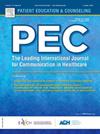Nonverbal behavior in telehealth visits: A narrative review
IF 2.9
2区 医学
Q2 PUBLIC, ENVIRONMENTAL & OCCUPATIONAL HEALTH
引用次数: 0
Abstract
Objectives
To synthesize findings from research examining nonverbal behavior (NVB) in telehealth. Use of telehealth has increased substantially in recent years—thus, it is critical to identify nonverbal strategies that facilitate positive patient-provider communication in this context.
Methods
Four peer-reviewed databases were searched: PubMed, PsycINFO, CINAHL, and EMBASE. Following a review of abstracts and full texts by the first author, 50 studies met inclusion criteria.
Results
The role of six NVBs– gaze, facial expression, gesture, head movement, proxemics, and posture– has been examined in the context of telehealth. Most included studies assessed patients’ and providers’ perspectives of NVB in telehealth. There was a lack of research examining nonverbal behaviors, and their associations with patient-centered outcomes, in naturalistic clinical settings.
Conclusions
While this review identified some promising nonverbal strategies to facilitate patient-provider rapport in telehealth, there is a need for future research that objectively measures NVBs and examines relationships between these behaviors and patient-centered outcomes.
Practice implications
Potential strategies for providers to enhance quality of communication in telehealth include gazing at the camera (vs. the screen), mirroring patients’ facial expressions and head movements, leaning forward, and exaggerating gestures and facial expressions.
远程医疗访问中的非语言行为:叙述性回顾。
目的:综合远程医疗中非语言行为的研究结果。近年来,远程医疗的使用大幅增加,因此,在这种情况下,确定促进患者与提供者积极沟通的非语言策略至关重要。方法:检索PubMed、PsycINFO、CINAHL、EMBASE 4个同行评议数据库。在对第一作者的摘要和全文进行审查后,有50项研究符合纳入标准。结果:在远程医疗情境下,研究了凝视、面部表情、手势、头部运动、体位和姿势这六种非谓语动词的作用。大多数纳入的研究评估了患者和提供者对远程保健中非自愿行为的看法。在自然主义的临床环境中,缺乏对非语言行为及其与以病人为中心的结果之间关系的研究。结论:虽然本综述确定了一些有前途的非语言策略,以促进远程医疗中患者与提供者的关系,但仍需要进一步的研究来客观地衡量非语言行为,并检查这些行为与以患者为中心的结果之间的关系。实践影响:提供者提高远程医疗通信质量的潜在策略包括凝视摄像机(相对于屏幕)、反映患者的面部表情和头部运动、身体前倾以及夸大手势和面部表情。
本文章由计算机程序翻译,如有差异,请以英文原文为准。
求助全文
约1分钟内获得全文
求助全文
来源期刊

Patient Education and Counseling
医学-公共卫生、环境卫生与职业卫生
CiteScore
5.60
自引率
11.40%
发文量
384
审稿时长
46 days
期刊介绍:
Patient Education and Counseling is an interdisciplinary, international journal for patient education and health promotion researchers, managers and clinicians. The journal seeks to explore and elucidate the educational, counseling and communication models in health care. Its aim is to provide a forum for fundamental as well as applied research, and to promote the study of organizational issues involved with the delivery of patient education, counseling, health promotion services and training models in improving communication between providers and patients.
 求助内容:
求助内容: 应助结果提醒方式:
应助结果提醒方式:


